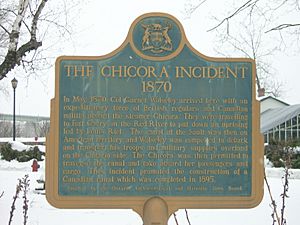Chicora incident facts for kids
| Date | May 1870 |
|---|---|
| Location | Sault Sainte Marie |
| Cause | Red River Rebellion Refusal to allow Chicora to pass through locks |
| Participants | United States Colonel Garnet Wolseley |
| Outcome | Chicora allowed to pass thourgh canal Building of the Sault Ste. Marie Canal |
The Chicora incident was an event in May 1870. It happened in Sault Sainte Marie, a town on the border between Canada and the United States. This event involved the American government and a group of British and Canadian soldiers. These soldiers were led by Colonel Garnet Wolseley. American officials stopped a ship called the Chicora from passing through a canal. This delay caused problems for Wolseley's mission to help with the Red River Rebellion. Because of this incident, Canada later built its own canal, the Sault Ste. Marie Canal. This new canal made sure Canadian ships could always travel between Lake Huron and Lake Superior.
What Happened?
In May 1870, Colonel Wolseley and his British troops were on their way west. They were traveling on a steamer ship named the Chicora. Their goal was to bring supplies, soldiers, and weapons to Fort Garry in Manitoba. This was to help stop the Red River Rebellion, a conflict happening in that area.
The Canal Blockade
The Sault Sainte Marie Canal was managed by the United States at that time. American officials would not let the Chicora pass through the canal's locks. There were a few reasons for this. One reason was that Colonel Wolseley had supported the Southern states during the American Civil War. Also, the Chicora itself had been used to help ships get past blockades during that war.
Because of this, the Chicora had to unload its passengers and supplies. The soldiers had to carry everything by hand from Lake Huron to Lake Superior. But even after unloading, the ship still couldn't pass. It was stuck for two weeks. Finally, the British ambassador to the United States, Edward Thornton, 2nd Count of Cacilhas, stepped in. After his help, the Chicora was allowed to go through the locks.
Building a Canadian Canal
This incident made Canada realize something important. It showed that Canada depended on the American canal for travel between the Great Lakes. This was a problem for Canadian independence and trade. So, the incident encouraged Canada to build its own canal. The Sault Ste. Marie Canal on the Canadian side was finished in 1895. This new canal gave Canada its own direct water route.
How It's Remembered
Today, the Chicora incident is remembered with an Ontario Heritage Trust plaque. This plaque helps people learn about the event. Staff at the Sault Ste. Marie Canal also share the story of the incident. They help visitors understand its importance in Canadian history.


